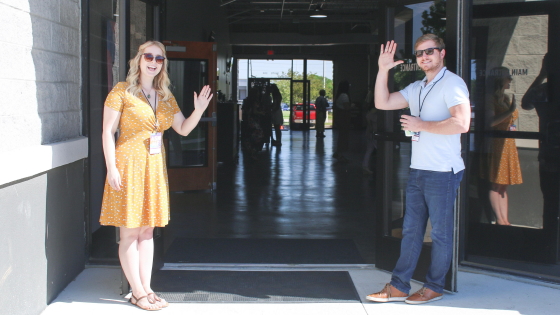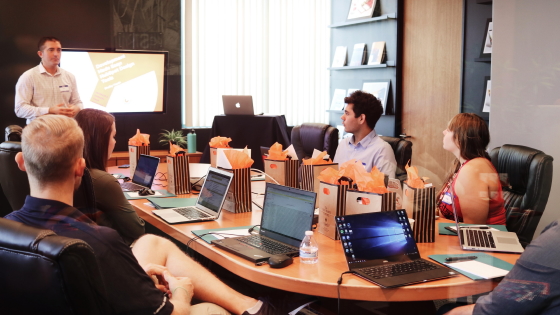10 things to work on to welcome newcomers in open source development

By
The shortage of human resources is a common problem in every workplace, but even if new employees are welcomed, it is possible that the newcomers will quit soon if the acceptance system is insufficient. Teams such as Dan Scholar, who studies data science at the University of California, talk about what to do to welcome newcomers and grow as part of the project in open source software projects.
Ten simple rules for helping newcomers become contributors to open projects
https://journals.plos.org/ploscompbiol/article?id=10.1371%2Fjournal.pcbi.1007296
◆ 1: Welcome newcomers
Scholler says that open source projects require a kind and polite social environment. In order to improve the motivation of newcomers as well as simply welcome them, it is effective to introduce newcomers and post welcome messages on the project's social media pages, forums, and mailing lists.
It's also important to get a job that matches the capabilities of the newcomer and to make sure that the newcomer is a necessary part of the project. Scholar recommends that existing members do not fix low-priority bugs or problems and leave them to the newcomer to create a “new job”. It is also recommended to appoint one or two supervisors so that newcomers can ask questions without hesitation.

By
◆ 2: Classify projects
The first important step to take for a project to welcome newcomers is to determine whether the project is suitable for the newcomer's interests and abilities. To do this, you need to understand what newcomers want to learn and what they want to give back to the project community.
For example , like LibreOffice, developers can classify tasks according to the skills and difficulty required, and by specifying the types of skills required for each project, newcomers can choose the project that suits them That's why.

By
◆ 3: Specify governance
To make the project run smoothly, Scholler says that it is necessary to clarify the governance of the project and to clarify who has the right to become a leader and what to decide.
Scholler introduces three ways to determine the leader, first the project founder becomes the leader. It's a common way of deciding a leader for a new project or a small project, but it's not a good way to do it, and another person can get leadership.
Second, instead of deciding on a single leader, the whole community has the right to decide. Scholler cites Martha's rules as an example. Instead of anyone submitting a proposal, the rule is that it cannot be adopted without the consent of almost everyone.
The third way is to create the conditions for human beings to be leaders. Leaders are selected by elections from people who meet the requirements such as qualifications and years of project enrollment.

By
◆ 4: Keep information up to date
Scholar says it is important for newcomers to have access to the information they need from Wikis, GitHub files, email archives, and more. By keeping the information in one place, Sholer says that newcomers can quickly access the information they need to solve their questions and increase their confidence and awareness. Also, old materials can be misleading to newcomers, so information should always be kept new.
It is also effective to place manuals and guidelines where they are easy to find. For example, you can place manuals in the CONTRIBUTING.md file according to the method recommended by GitHub, or place manuals and learning modules that can be accessed on the web, such as Apache Open Office Suite .

By glennoble
◆ 5: Establishing a code of conduct
Community leaders need to demonstrate a code of conduct within the community based on experience. Having a code of conduct makes it easier for people with different cultural backgrounds to access the project.
It is also effective to adopt a code of conduct that already exists. Many projects such as rOpenSci , NumPy , and Project Jupyter employ Contributor Covenant or implement the SciPy Code of Conduct.
Project leaders need to make public any violations, such as verbal or written warnings, deprivation of access to project communication means such as mailing lists, and exclusion from the project. there is. If the violator is not punished, the community may think that the code of conduct is meaningless.

By
◆ 6: Create a project format that makes it easy for members to participate
Newcomers become part of the project by performing simple, low-risk tasks. When working in a community such as GitHub, doing core activities such as committing code and sending pull requests is a heavy burden for newcomers. Instead, it is recommended that you report a problem when you notice a bug or help a newcomer with translation and localization documentation.
Having multiple ways to participate in a project can make it easier for newcomers to join the community and help newcomers understand that work that requires skills is not the only job of the project.

By
◆ 7: Let newcomers start working immediately
Scholler said that it ’s important to make it easy for newcomers to get involved in the project, so that newcomers can start working immediately. Changing the attitude of working on a project from “I want to help” to “I can help / help” is the way everyone goes. If a problem occurs during the step-up, it becomes a big barrier to newcomer community participation. You can save time by automating as many setup processes as possible and documenting those that take time to understand.

By
◆ 8: Emphasis on face-to-face communication
Open source software projects have more remote workers communicating via email and video. Face-to-face conversations help facilitate mutual understanding . Therefore, it is important to include newcomers in face-to-face exchanges. By setting up an event for newcomers and having newcomers participate in large gatherings such as conferences, the economic cost and burden on participants will be reduced.
For members who are introverted or are not confident in face-to-face conversations, face-to-face communication may be uncomfortable. However, if you do not attend the meeting, you may not feel part of the community.
When communicating face to face with multiple people, all members should share information such as simple notes so that all members can understand the conversation. Examples include displaying a chat log on the screen and sticking a sticky note with a note on the whiteboard.

By
◆ 9: Accept all jobs
Scholler says it is important to recognize the new job and appreciate it. You need to be aware of the importance of time your members have spent for the project and be careful not to sacrifice time in the form of overtime.
Rather than just thank you, you should ensure that your work is fair by publishing guidelines that describe how all projects are organized and how they work. It is recommended to create a concise document on who can use the data created by the project for what purpose, what compensation is given to those who have completed the project, and who owns the copyright. It has been.

By
◆ 10: Follow-up of success and failure
After the newcomer finishes his first job, you need to think about ways to improve how he can help the newcomer in the project. Helping newcomers find the next challenge to work on and nurturing newcomers to help the next newcomer can be a good opportunity to review what they have learned.
It is also important to analyze the members who have quit. Was the job given inappropriate or was it too difficult to set up to start the job given? Or you should consider whether you didn't feel uncomfortable or underestimated in the community. In most cases, conversations with individual members should be kept confidential, but publishing conclusions and corrective actions on the cause of the member's retirement to the community indicates that it is serious about building the community. 'Shorer said.

By jtylernix
Related Posts:
in Software, Posted by darkhorse_log







